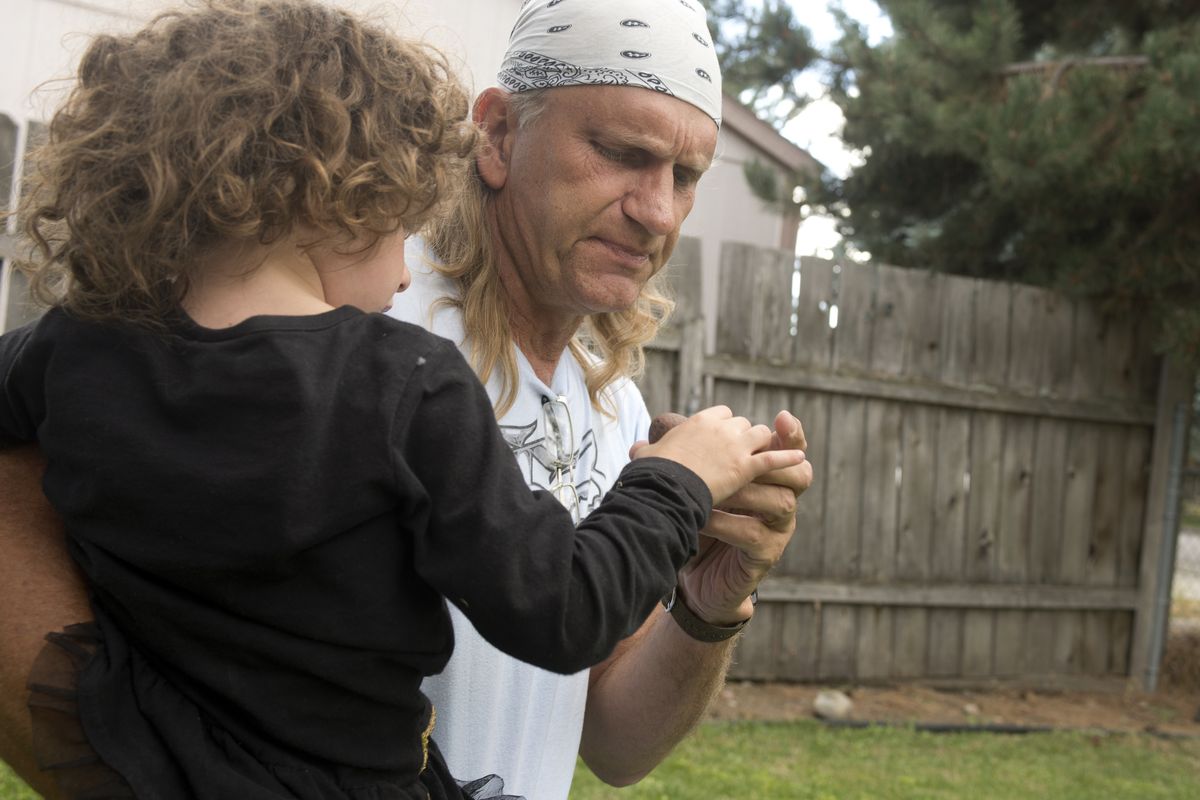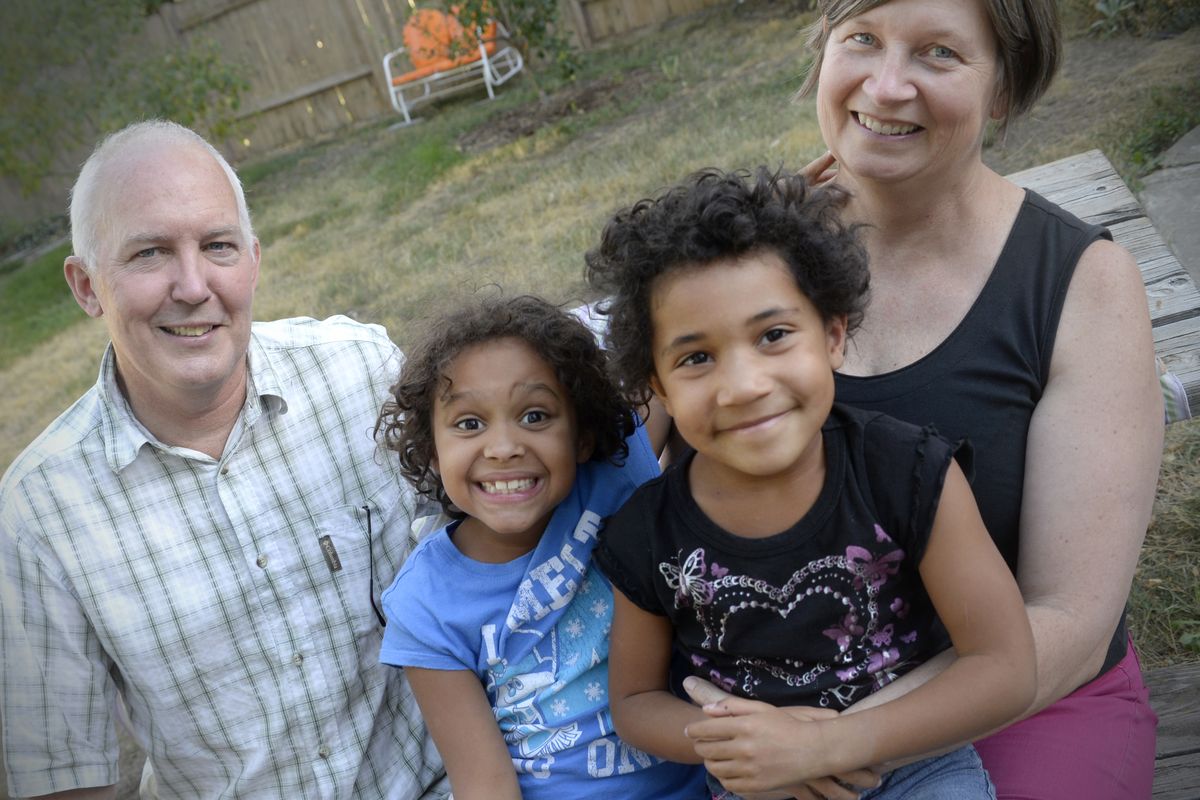People adopting children when most are thinking retirement
Bob Salsbury takes a rock handed to him by his granddaughter at his Spokane Valley home. He’s in the process of adopting her.
There was a little RV in Bob Salsbury’s imaginary retirement, or maybe a Volkswagen van. He’d drive to the coast and camp on the shore. He’d hike and wander the beaches, a “crazy old man” gathering agate and sea glass.
Salsbury had worked for the state since Jimmy Carter was president. He’d raised three children. He was ready to retire.
He still is, and he still will. But now there’s a curly-haired little girl in the picture – his granddaughter, who loves flowers and butterflies, whose paintings and drawings hang throughout their Spokane Valley home – whom he’s adopting after his daughter and the girl’s biological father relinquished their parental rights.
It’s a move more AARP-eligible adults are making, adopting children as first-time parents or tapping into previous experience as parents, by adopting the children of younger relatives who can’t do it themselves.
Adoption advocates say it’s a welcome shift that results in more children – including those in foster care – living in loving, stable homes. Some area adoptive parents, looking into preschools as their peers deliver kids to college, say their maturity and life experience are a benefit.
Salsbury, 56 – who works in juvenile rehabilitation for the Department of Social and Health Services – said he feels lucky to be raising his granddaughter. They take his sea kayak out on lakes. They camp and ski. He wrangles her hair into “messy buns,” taking lessons from YouTube.
But the decision to parent a child in your 50s or beyond affects every domain of life, Salsbury said. It requires him to pay more attention to his own health. It complicates his dating prospects.
And “this vision of this retirement with very few anchor lines, with very few responsibilities – the typical kind of retirement … that dream: Boom.”
Changing practices
While adoption advocates say no one tracks adoptive parents’ ages, in recent years they’ve seen more people in their 50s and older embarking on parenthood.
“There’s a lot more opportunity for older parents today than in the past,” said Chuck Johnson, president of the Alexandria, Virginia-based National Council for Adoption, who started working in the field 28 years ago at an adoption agency that capped adoptive parents at age 40.
The change reflects more openness by adoption agencies in general, Johnson said, that also extends to single parents and same-sex couples. And it reflects a couple of reigning principles in adoption and child-welfare circles: First, every child – including foster children once deemed “unadoptable” – deserves a permanent, loving home. Second: Children whose parents can’t raise them should be raised instead by other biological relatives, if possible, including grandparents or great-aunts and -uncles.
The change also reflects lifestyle factors leading many families – adoptive or otherwise – to put off parenthood, said Gloria Hochman, communications director at the National Adoption Center, based in Philadelphia.
People are marrying later and women are staying in the work force longer before thinking about kids, she said. When they have trouble having children naturally, they turn to adoption.
Or, like South Hill residents Bob Steinauer, 58, and Beth Torgerson, 51, they turn to adoption first. The couple married a decade ago. Their daughters are now 8 and 5.
Steinauer, a botanist, was 50 when they adopted their first daughter, Kendra, as a newborn.
He’s done the math. He’ll be 70 by the time both daughters are done with high school. He has noticed, when he volunteers at Kendra’s school, that he’s old enough to be other parents’ parent.
His biggest concern about his age is staying fit enough to do the things he wants to do with his kids, like riding bikes and going on hikes.
“Having a wife and having kids – that’s the best thing that’s ever happened in my life,” Steinauer said. “The kids are a treasure. Even at this age, to have kids – they’re still the most important part of my life.”
Lasting the duration
But, as Johnson from the National Council for Adoption said, no one’s saying age doesn’t matter.
In June, the council published an article about the causes of “broken adoptions” handled by Family Court in New York City. A six-month study found the vast majority resulted from the parent’s death (53 percent) or infirmity (22 percent). The article called some of the parents’ ages “startling”: A 66-year-old had adopted a 4-year-old; a 67-year-old had adopted an infant.
“Life expectancy is an issue,” Johnson said. “And you’re talking about children who have already suffered some loss already through the separation with their biological families. If they’re adopted by someone who might not survive the full childhood, it’s just another traumatic experience.”
Prospective parents’ overall health is always part of the discussion at Spokane Consultants in Family Living, adoption coordinator Maureen Reilly said.
Birth mothers want adoptive parents likely to be around until their kids are adults. And “it’s tiring,” Reilly said. “It’s physically tiring to parent, to chase a 2-year-old around.”
In terms of age, the state of Washington only requires adoptive parents to be 18 or older. But private agencies like Reilly’s can set their own requirements. Spokane Consultants’ website says it requires parents to be 28 to 45.
If they’re older, Reilly said, she’s willing to talk – though “I scratch my head, in all honesty … I don’t think I would start parenting in my 50s.”
Along with health status, she wants to know their story: Why now?
“If they’ve been married a long time and really hadn’t thought about having children,” she said, “we really get down to why – what makes you really motivated and committed to parenting at this late stage in your life? We always look big-picture.”
‘In a better place’
Experienced parents looking to add to their family – maybe on second marriages – can be good for a toddler or older child who’s been bounced around among temporary caregivers, she said. They can provide the hours of rocking, holding and maybe bottle-feeding that a young child who missed out on those things needs, she said.
Their age and experience would be good for “the kiddo that needs to be ‘re-babied,’ (who has) attachment issues,” Reilly said.
In fact, age and experience can give some adoptive parents a leg up, regardless of their children’s histories.
Some days, south Spokane resident Janice Medlock, 50, would like to get more sleep. But being an older mother with little kids has its advantages, she said, and she wouldn’t have chosen to start her family earlier.
Medlock is in the process of adopting her two youngest boys, ages 2 and 3. Her older sons are Christopher, 7, whose adoption became final in June, and Byron, 11, adopted at 3 and in her care since he was 6 months old.
Medlock is single. That part, at least, was part of her plan – she would stay single forever, doing what she wanted when she wanted. She especially loved travel.
Byron moved in at a few months old with his biological mother, Medlock’s then-teenage niece, who soon relinquished her parental rights.
“The second I held him, I looked into his little eyes, and I just kind of knew,” said Medlock, an accountant at The Spokesman-Review. “This was where my life was heading.”
Christopher’s biological mother is a woman she’d met by chance a couple of times, before the state became involved in his care. The youngest boys also were born to Medlock’s niece, who could not care for them either.
Her life, while unexpected, feels right, Medlock said. She grew up in Spokane surrounded by cousins and siblings.
At 50, “I’m a little wiser,” she said. “And I’m a little more settled. I don’t feel like I’m missing out on anything, because I did do what I wanted to do when I wanted to do it. And I look at them, and they are so full of life and so happy. They just bring an amazing amount of joy.”
Torgerson, who teaches English at Eastern Washington University, said she’s better able to navigate the emotionally fraught parts of adoption than she might have been as a younger mother. That includes contact with Kendra’s biological relatives.
The family travels annually to Florida, where both girls were adopted, to visit Kendra’s birth mother. While 5-year-old Nikki’s adoption also is technically open, her birth mother hasn’t reached out.
So, along with Kendra’s birth relatives during those Florida trips, the family visits Nikki’s godmother. It’s partly an effort to spare Nikki from feeling left out.
“To me, that’s the best part of being older. You can see the big picture,” Torgerson said. “All adoption stories have really sad parts to them. I mean, a parent would not give up their child by choice. You have to accept that’s a fact. But it also means you have to work with it. I think, at least I hope, I’m in a better place to work with the sadness of it.”
‘Part of the puzzle’
Salsbury said he had some early doubts about raising his granddaughter.
“Here I am, a set-in-his-ways 50-whatever-year-old,” he said. “And here’s this little girl with curly hair, very feminine, who color-coordinates – better than I ever could – her own clothing. I said, ‘OK, I’m just part of the puzzle.’ I’m the primary caregiver, but there’s other people in her life.” They include his own parents, who live nearby.
As it turns out, he said, he has better parenting skills this time around. He’s more patient, more thoughtful – “mellower,” he said. He has more money and less stress.
Divorced when his sons were 8 and 10 and his daughter in high school, he raised his kids with a “boot camp mentality” that his sons resisted.
The summer when his granddaughter was 3, he took 12 weeks of leave from work to spend with her, allowed through the Family and Medical Leave Act.
They took his kayak to Idaho, where they paddled around, hunting water lilies. He taught her, too, as he learned to airbrush.
It’s not that he loves her any less than his three older children, but in raising a grandchild, he said, “there’s a little more space that’s a really healthy thing. It gives you time to see more options, to move around.
“Honestly … there are times when I’m with her and I’ve been like, ‘Gosh, I wish I’d been more like this with my own kids.’ ”

